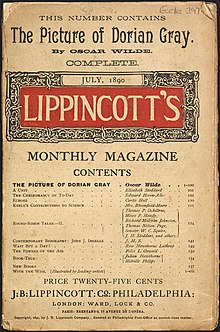Our website is made possible by displaying online advertisements to our visitors.
Please consider supporting us by disabling your ad blocker.
The Picture of Dorian Gray
 The story was first published in 1890 in Lippincott's Monthly Magazine | |
| Author | Oscar Wilde |
|---|---|
| Language | English |
| Genre | Philosophical fiction, Gothic fiction, decadent literature |
| Published | 1890 Lippincott's Monthly Magazine |
| Publication place | United Kingdom |
| Media type | |
| OCLC | 53071567 |
| 823.8 | |
| LC Class | PR5819.A2 |
| Text | The Picture of Dorian Gray at Wikisource |
The Picture of Dorian Gray is a philosophical fiction and gothic horror novel by Irish writer Oscar Wilde. A shorter novella-length version was published in the July 1890 issue of the American periodical Lippincott's Monthly Magazine.[1][2] The novel-length version was published in April 1891. It is regarded as a classic of Gothic literature and has been adapted for films and stage performances.
The story revolves around a portrait of Dorian Gray painted by Basil Hallward, a friend of Dorian's and an artist infatuated with Dorian's beauty. Through Basil, Dorian meets Lord Henry Wotton and is soon enthralled by the aristocrat's hedonistic worldview: that beauty and sensual fulfilment are the only things worth pursuing in life. Knowing that he will lose his beauty with time, Dorian impulsively chooses to sell his soul and asks for the portrait, rather than himself, to age and fade. His wish granted, Dorian pursues a libertine life of varied amoral experiences while staying young and beautiful; all the while, his portrait ages and visually records every one of Dorian's sins.[3]
Wilde's only novel, it was subject to much controversy and criticism in its time but has come to be recognised as a classic of Gothic literature.
- ^ The Picture of Dorian Gray (Penguin Classics) – Introduction
- ^ McCrum, Robert (24 March 2014). "The 100 best novels: No 27 – The Picture of Dorian Gray by Oscar Wilde (1891)". The Guardian. Retrieved 11 August 2018.
- ^ The Picture of Dorian Gray (Project Gutenberg 20-chapter version), line 3479 et seq. in plain text (Chapter VII).
Previous Page Next Page


